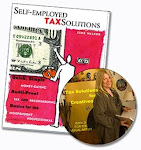June --
I am not a tax professional but I believe there is an issue that would cost a taxpayer money on the federal return if the 1099 he/she receives includes expenses... You cannot deduct dollar-for-dollar some meal and T&E expenses on your federal return...therefore if those expenses are reimbursed at 100% and included on the 1099 you can only deduct the allowable percentage on your return...so it behooves the corporation providing the 1099 to include the expenses on it but it is to your disadvantage...correct?
Herb
Incorrect, Herb. First, so that we are all on the same page: It's not "meal and T&E." I assume you mean by "T" travel expenses. It's M&E for meals and entertainment. M&E expenses are deductible at 50% by the indie or corporation that incurred the expense. [There are exceptions which I will not go into here. You may read a lot more M&E here expenses -- meals and entertainment.]
That means that if Victor Visual takes a client out for a business dinner and he spends $200, he may deduct only $100 on as a business M&E deduction. The same would apply were Callous Corporation to take out a client for dinner.
Callous Corp engages Victor for a design project and will pay Victor $3,000. In doing that project Victor must wine and dine some folks at a cost -- to the corporation -- of $500. Victor bills the corporation $3500. $3000 for his fee as well as $500 to reimburse him for expenses. Same way he would get reimbursed were he to have had $500 in printing costs for Callous.
Callous pays Victor the $3500 and is allowed to deduct the entire fee of $3000. However, Callous may deduct only $250 for the M&E. It was Callous's expense not Victor's.
Of course, if Victor's arrangement with Callous said that his fee covered all expenses, he would not be reimbursed and he would deduct only 50% of his M&E expenses.
Many payers, Like Callous Corp, include M&E expenses on the 1099 in order to cheat the IRS. That is Callous's and the IRS's problem, not yours. As long as you have proof of your arrangement with Callous and receipts to prove the reimbursement arrangement you take 100% of the deduction.
Here are more posts on expenses -- reimbursed .
You said you are not an accountant, but I am going to give you some accounting jargon here anyway. Just in case you want to pass it on to Sammy Segar CPA who doesn't agree.
I've often explained in my seminars and writing that I take the tax code and put it into language that my talented indie readers will understand. Here's a short example, already simplified from the tax code verbiage but I think you'll get the idea. By the way, the interpretation from employee to indie that applies to indies is in red:
Where meal and/or entertainment expenses incurred in connection with the performance of services are reimbursed, the directly-related-to and associated-with tests for the deductibility of the expenses are applied to the taxpayer who actually claims the expenditure as a deduction. Similar rules apply for the Code Sec. 274(n) percentage limitation on the deduction (the 50% limit) [S Rept No. 99-313 (PL 99-514) p. 71]. Specifically, the 50% limit doesn't apply to expenses described by Code Sec. 274(e)(3) which are expenses incurred in connection with performing services under a reimbursement or other expense allowance arrangement for an employer, if the expense isn't treated as compensation, or for a person other than an employer, if the taxpayer adequately accounts to that person for those expenses [Code Sec. 274(n)(2)(A)]
Similarly, a nonemployee service provider (e.g., an independent contractor) that provides the required substantiation to and is reimbursed by the service-recipient for meal and entertainment expenses incurred on the latter's behalf isn't subject to the percentage reduction rule. The rule applies to the service-recipient, who can deduct only 50% of the reimbursement. Notice 87-23].
Once again thanks to NATP for research help.
-- June
Subscribe to:
Post Comments (Atom)





No comments:
Post a Comment